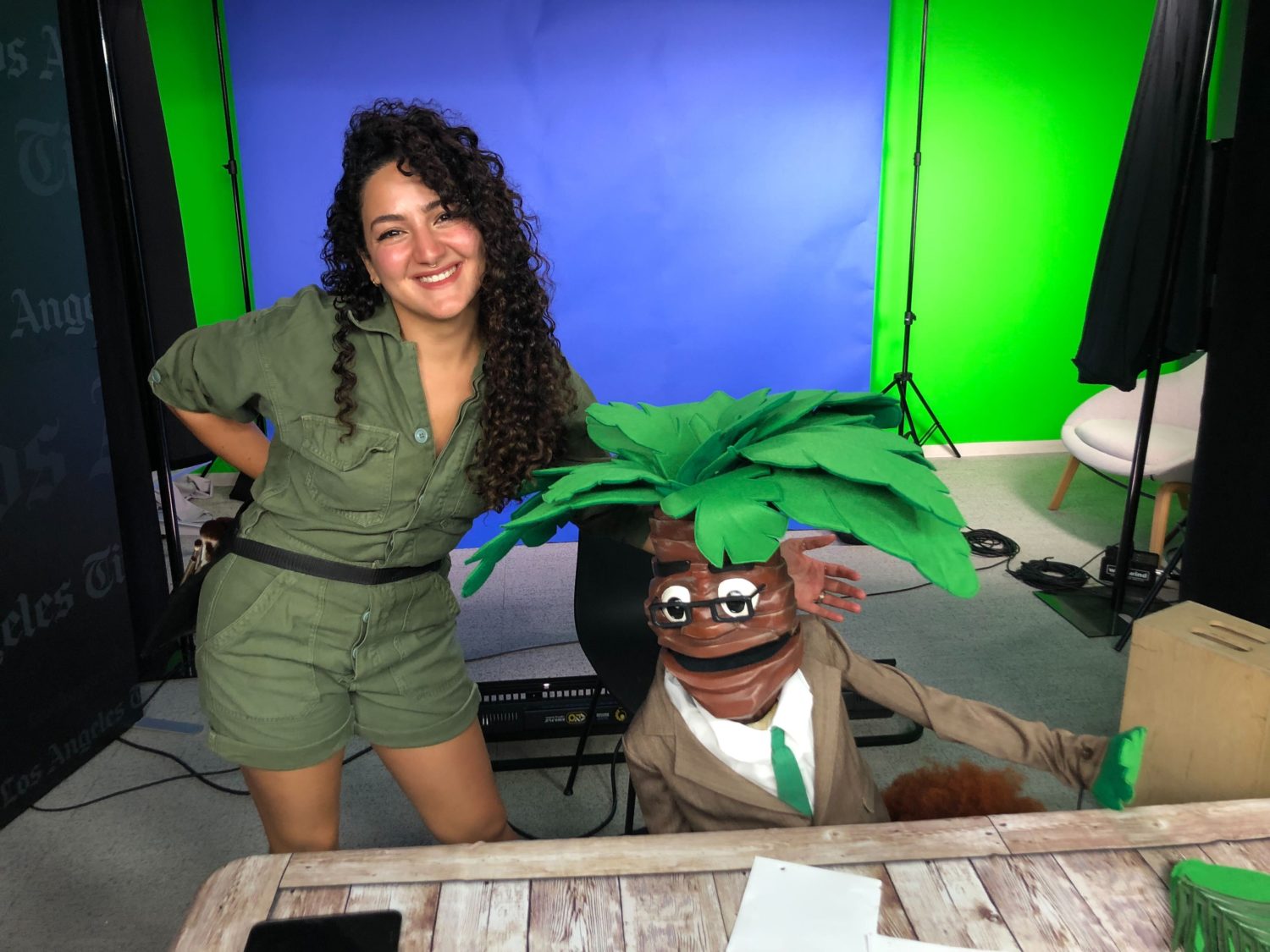When Salma Loum first visited California, one of the first places she went was the world-famous Hollywood Walk of Fame.
“You have this image in your head, when you’re an immigrant, that this is going to be like the finest of Hollywood,” recalled Loum, who is from Egypt.
The college student expected glitz and glam. What she found instead hit her hard. Every few steps on the iconic walk there was a homeless person. She wondered how she could help.
That visit was more than a decade ago, but the experience stayed with Loum, who is now a data journalist. She still had questions around homelessness, such as: How do you define homeless people? Do you define homeless people in your neighborhood as your neighbors?
Loum’s desire to make an impact led her to pitch the idea for “Head-lines,” a news show for children that’s run by puppets. In October, the Los Angeles Times, where Loum was a member of its 2021-2022 Los Angeles Times Fellowship class, partnered with the Bob Baker Marionette Theater to produce the four-episode video series focused on mental health concepts. Two puppets – a palm tree named Palmy Nomanderson, who is an award-winning journalist from Jamaica, and Lora Jacaranda, a Pasadena parrot who is the “Head-lines” reporter on the streets of L.A. – break down the concepts for children.
“All this education starts from youth, right? When we’re young, we start building all these skill sets that we put in our toolbox: to talk about mental health, having all this communication open to being able to express our feelings, things like that,” said Loum, who is the creator-director of the series and now a freelance data journalist. “And I felt like it was really imperative to teach our youth about what it means to be homeless in the United States, especially in L.A.”
The project – part of the newspaper’s mental health initiative, For Your Mind – features four episodes: The first two focused on anxiety and homelessness. The remaining episodes that will be released later this month will cover fear and grief. “Head-lines” offers coping skills and has resources and conversation starters on the subjects to help adults engage the young people in their lives.
To Jaclyn Cosgrove, assistant mental health editor for the Los Angeles Times and an executive producer on the project, “Head-lines” is a blend of mental health and media literacy. “Palmy is a news anchor, and Lora is a reporter on the street. It’s introducing kids to those concepts, too, while also it’s a show about mental health,” they said. “I feel like there’s a multi-layered approach that we were thinking on here. We wanted these kids to begin to understand how journalists acted, basically, albeit that these two are a little bit silly.”
Lora, the parrot reporter, was custom built for the series, according to Winona Bechtle, director of development and partnerships at Bob Baker Marionette Theater. She said her team wanted to create a puppet that “could convincingly engage in ‘live’ conversation out on the street. Palmy, she said, was created with “the classic television news anchor in mind – but with a streak of sweetness and charm that we also hoped would be disarming and kind for our audience.” The puppets were intricately made: Their bodies were made of foam, Palmy’s face and Lora’s beak were 3D printed, and Lora’s feathers were made of laser-cut felt.
Bechtle said that they wanted the characters to be both interactive and reflective of Los Angeles. “This project was an exciting opportunity to make two new puppets from scratch that really paid homage to LA, so we decided that the classic palm trees that line the streets of most neighborhoods, and the quintessential green parrots that fly around and squawk all day were great characters to start with,” she said in an email.
This series, Bechtle said, was a true partnership. At every step of the way, she said her team tried to determine how best to support the project. She added that her team felt that the journalists at the Los Angeles Times “were really wanting to push the boundaries of what is possible when puppetry meets news.”

Salma Loum, a data journalist and the creator-director of the “Head-lines” series, poses with the puppet, Palmy Nomanderson, on set.
(Photo courtesy of the Los Angeles Times)
In the episode on homelessness, Palmy is at his anchor desk about to deliver a story about a Santa Monica sea lion who became an Internet sensation when he abruptly stops. He says there’s something weighing on his mind and the voice of an apparent producer takes the show off the air. When they’re back on a few seconds later, Palmy shares that his dear friend, Eucalyptus, and her son had to leave their apartment after she got sick, lost her job and fell behind in rent. They’re homeless now.
“I think it’s important to talk about our friends, and everyone in our community experiencing homelessness,” Palmy says.
The news anchor with bright green palm leaves topping his head immediately dives into a story about homelessness. He brings child psychiatrist Dr. Roya Ijadi-Maghsoodi on the show to explain what it means to be homeless and for guidance on how to talk about it. “It doesn’t mean that anyone’s done anything wrong or bad to become homeless, and in our city a lot of people become homeless simply because they don’t have enough money to pay the rent for the place that they’re living in,” Ijadi-Maghsoodi explains. “It also doesn’t mean that it may happen to you or your family, but it’s something that we can think about helping.”
Palmy then gives airtime to Lora, who is reporting live from the street and interviews a boy named James. He shares his experience of seeing homeless people near some tents while out with his mother. James says he thought about waving to them, but he felt nervous and crossed the street with his mom. He wants to know if there’s anything he can do to help them. Ijadi-Maghsoodi then shares her thoughts. The show then turns it over back to Lori, who enlists James to ask other children what home means to them.
Creating each episode involved a lot of work and behind-the-scenes coordination. Cosgrove, Loum and reporters Lila Seidman and Colleen Shalby consulted the children and parents in their lives.
“We’ve all had to kind of slow down and think, ‘What would a child understand?’” Cosgrove said. “As a journalist, you have to think about your audience. And in this case, our audience was kids. And we really wanted this to be content that first and foremost would serve kids, but then maybe as adults, you would find yourself watching it, too.”
Loum said she’d like to see “Head-lines” open a line of communication between children and the adults in their lives.
“My hope is that this is useful for someone so they don’t have to figure this information out when they’re in their 30s. They can just acknowledge this, be able to help to the best of their ability when you’re 7 or 10,” she said. “I feel like that’s a step ahead of the problems. We can add all these tools and our skill sets in our communication, and just be able to talk and have an honest conversation about issues in our society involving mental health.”






